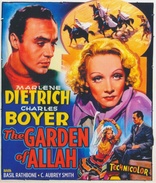The Garden of Allah Blu-ray Movie
HomeThe Garden of Allah Blu-ray Movie 
Kino Lorber | 1936 | 79 min | Not rated | Jan 09, 2018Movie rating
6.5 | / 10 |
Blu-ray rating
| Users | 0.0 | |
| Reviewer | 3.0 | |
| Overall | 3.0 |
Overview
The Garden of Allah (1936)
After the death of her father, convent-educated Domini Enfilden heads for the desert seeking peace. But instead of tranquility, the sultry beauty finds passion in the arms of Boris Androvsky — secretly a Trappist monk who has broken his vows and lost his faith. Will Domini discover Boris' secret, and will his hidden past destroy their future happiness?
Starring: Marlene Dietrich, Charles Boyer (I), Tilly Losch, Basil Rathbone, C. Aubrey SmithDirector: Richard Boleslawski
| Romance | Uncertain |
| Drama | Uncertain |
| Adventure | Uncertain |
Specifications
Video
Video codec: MPEG-4 AVC
Video resolution: 1080p
Aspect ratio: 1.33:1
Original aspect ratio: 1.37:1
Audio
English: DTS-HD Master Audio 2.0 (48kHz, 16-bit)
1562 kbps
Subtitles
English SDH
Discs
Blu-ray Disc
Single disc (1 BD)
Playback
Region A (C untested)
Review
Rating summary
| Movie | 4.0 | |
| Video | 3.0 | |
| Audio | 4.0 | |
| Extras | 0.5 | |
| Overall | 3.0 |
The Garden of Allah Blu-ray Movie Review
Reviewed by Dr. Stephen Larson January 12, 2018While David O. Selznick had been producing films since the early 1920s, he did not form his own independent studio at Selznick International Pictures until 1936 when he made the Freddie Bartholomew vehicle, Little Lord Fauntleroy, which was adapted from Frances Hodgson Burnett's novel. Later that year he produced another adaptation of a celebrated literary work, Robert Hichens's The Garden of Allah. Although the 1904 novel already had been adapted twice in the silent era, Selznick thought that he could do something fresh with the material but had his work cut out for him with a sprawling 480-page book. The script required two writers, W.P. Lipscomb (1935's Les Misérables and A Tale of Two Cities) and Lynn Riggs (Stingaree), and was considered one of the most expensive films for its day (cost estimates were around $2.3 million). According to film historian Bruce Eder, Marlene Dietrich had a dispute with Paramount Pictures and very luckily became available to Selznick who cast her to portray the heroine Domini Enfilden. French-born Charles Boyer had been acting in American movies since the early '30s and was cast to co-star with Dietrich as her lover, Boris Androvsky. The Garden of Allah also features supporting turns by studio regulars such as Basil Rathbone, C. Aubrey Smith, and John Carradine. Selznick planned for the film to break new ground in three-strip Technicolor but it was a scorching journey to bring it to the screen. The Oakland Tribune ran a special Sunday feature on The Garden of Allah which it headlined as the "HOTTEST ROMANCE EVER FILMED." The newspaper sent its correspondent J. Eugene Chrisman out to the Buttercup Valley among the Yuma sand dunes in Arizona to cover the filming with temperatures reaching 140 degrees!
The Garden of Allah begins almost obliquely, first in the sunset desert over the main titles and then transporting the audience to an old convent. There the devout Catholic Domini (Dietrich) has returned to the nunnery that she once abandoned. She's observed by the very young nuns in tow praying in the candle-lit chapel. Director Richard Boleslawski cuts to a seemingly parallel story at a monastery in northern Africa. A priest shows a French soldier around the quarters before sitting down at a very long table for a meeting of the brotherhood. The priest orders one of the young brothers to summon Trappist monk Boris Androvsky (Charles Boyer) from his cell but he is nowhere to be found. Boris has breached the monastery's code of poverty, silence, and chastity by venturing off into the world. Boleslawski shifts the locale to Beni-Mora and the parish of the benevolent Father J. Roubier (C. Aubrey Smith) amid the Algerian desert where Domini hopes to discover a new life adventure. Boris is also headed for this region and he later collides with Domini at a café featuring Ouled Naïl dancers, including Irena (Tilly Losch) whose a real show-stopper. Domini and Boris meet each other there and their romance takes up much of the film. Boris has a mysterious past that is being looking into by Count Ferdinand Anteoni (Basil Rathbone).
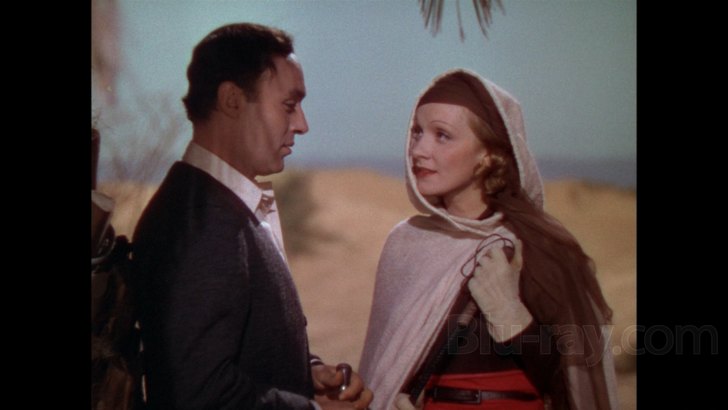
Boris and Domini gather in the desert.
The Garden of Allah is rather static and lacks much plot or action by I believe that this was intentional by the filmmakers. Had this been photographed in black-and-white, it would have been classified as a run-of-the-mill studio melodrama. But the carefully composed three-strip Technicolor draws the viewer to each hue and contour visible in the frame. Selznick inaugurated a new position for this production: the role of the color designer/director who, as one newspaper account described it, "supervised the colors employed in sets, costumes, props and decoration to assure pictorial harmony." This task was assigned to Lansing C. Holden, who helped cameramen W. Howard Greene and Harold Rosson win a special Academy Award for the group's Technicolor work. Holden once explained his philosophy for photographing in color: "Painters always had tricks of composition in which they use color. [French painter Jean-Baptiste-Camille] Corot, for instance would paint a misty landscape and draw the eye to a single spot of red on the bonnet of a peasant. That explains the rule by which a color director must work. He must make the center of interest the center of color....The day will come when color will be written into the picture with the same care as dialogue." Reviews were practically unanimous in their praise of the three-strip process, anointing The Garden of Allah as the most gorgeous movie photographed up to that point. A critic for the Baltimore Sun observed that "the camera has caught the delicate tones of dawns and sunsets, given unforgettable glimpses of caravans passing in silhouetted against the glowing sky, simulated moonlight, and fixed in celluloid the pastel shades of whirling sand....Most significant of all, [the cinematographers] have brought the color process to a new high point in depicting the human face. They have banished the green tints and sudden changes of complexion...Dietrich is the first actress whose loveliness is appreciably enhanced by the use of color; her eyes, in particular, acquire new beauty, and she is the first to solve the secret of color make-up." I am in the affirmative with the original reviewers that the achievement of Technicolor alone makes The Garden of Allah worth seeing.
The Garden of Allah Blu-ray Movie, Video Quality 
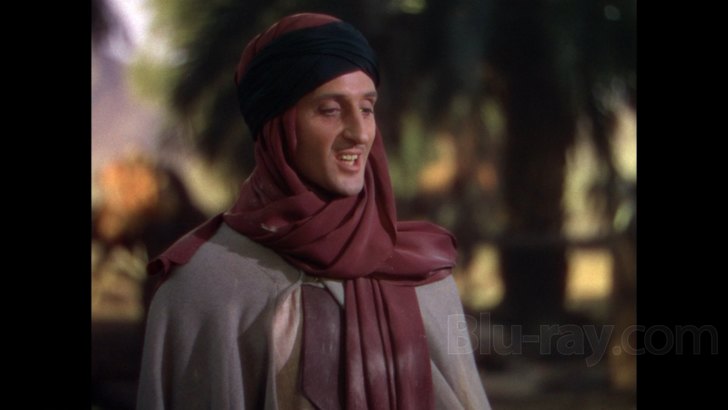
The Garden of Allah makes it initial splash on high-definition on this MPEG-4 AVC-encoded BD-25 courtesy of Kino Lorber Studio Classics. Appearing in Academy Ratio of about 1.33:1, the 1936 classic has been given a healthy average bitrate of 28123 kbps. I was hoping that Kino would derive its transfer from the same restored print that appeared on the 2000 Anchor Bay and the 2004 MGM DVDs but they've sourced a different archival print that's not as clean and sports video artifacts. DVD Talk's Glenn Erickson lauded MGM's image for appearing "in perfect shape; only a few shots exhibit color haloes indicating a misalignment of Technicolor matrices. The colors leap off the screen." By contrast, KL has a softer picture that occasionally displays color splotches in the form of small polka dots (see especially Screenshot #20). You can also spot some of the artifacts in frame capture #s 9 and 19. Additionally, there is some image flickering during extreme long shots, location exterior shots, and during reel transitions. I detected some dust particles in the opening shot (#18). I bought the MGM disc nearly eight years ago instead of the A.B. because it was more readily available and also had subtitles (which its predecessor lacked). I re-watched it after viewing KL's transfer and consider it to have a richer and bolder color palette, superior definition, and a clearer appearance. The Kino does contain more detail and grain, however. The Blu-ray has an above-average transfer but I'm disappointed that Kino did not work off the same print.
Kino provides only eight scene selections. (My MGM DVD has twenty chapter stops.)
The Garden of Allah Blu-ray Movie, Audio Quality 
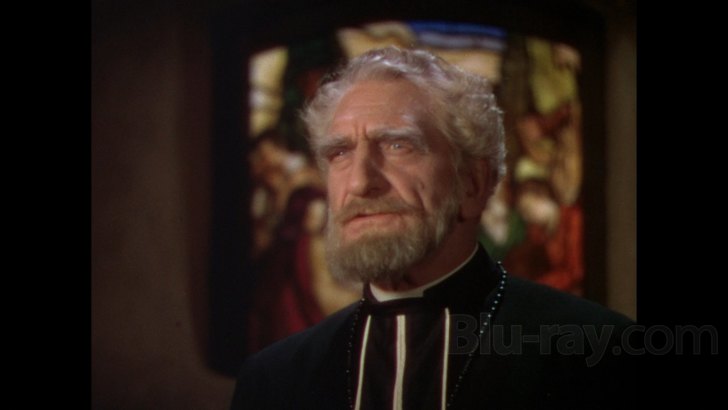
Kino renders the film's original monaural as an English DTS-HD Master Audio 2.0 Dual Mono (1562 kbps, 16-bit). It is in very good shape and is presented cleanly with good clarity on the sound track. I was able to discern all of the film's diverse regional and ethnic dialect without resorting to the optional English SDH. Max Steiner composed a grand, romantic, and Arabian-inspired score that shows good bass on the front channels. Audible hiss is kept to a minimum and distortion and tape-dropouts are blessedly non-existent.
The Garden of Allah Blu-ray Movie, Special Features and Extras 
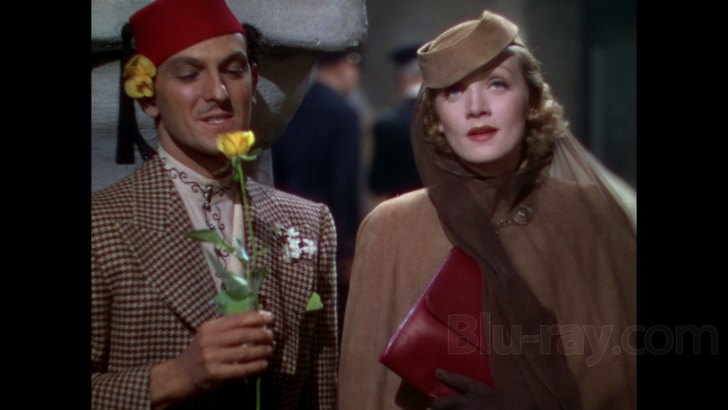
When I saw a "Bonus" option on the main menu, I was hoping for a commentary track from a historian but the only so-called "extras" are some trailers for other Dietrich titles in KL's catalog.
The Garden of Allah Blu-ray Movie, Overall Score and Recommendation 
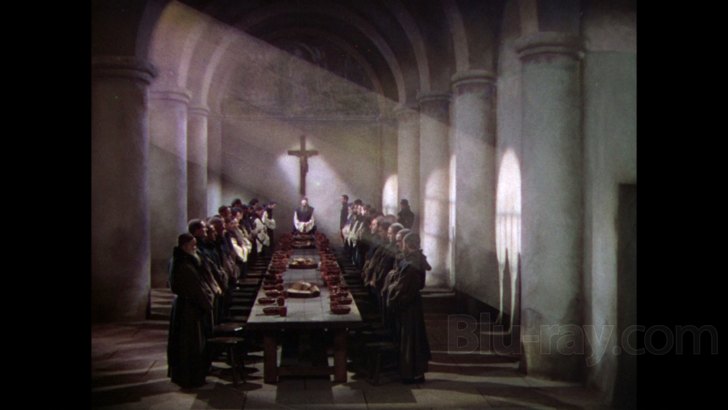
The Garden of Allah doesn't have a deep story and is very leisurely paced but Dietrich and Boyer make a fairly compelling screen couple. What elevates the film from the assembly line of period epics and melodramas is the extraordinary three-strip Technicolor, which isn't fully exploited on this disc. I wish that Kino Lorber would have licensed the older restoration that appeared on the two US DVDs. The transfer is for the most part okay but I would go for one of the OOP standard-definition discs. (The MGM can be bought new for $14.) KL does boast superior audio with the lossless sound track but offers no extra features. RECOMMENDED but with the qualifiers I've noted.
Similar titles
Similar titles you might also like

Picnic
Limited Edition to 3000 - SOLD OUT
1955

She
1935

Bird of Paradise
1932

Saratoga
Warner Archive Collection
1937

Kitty Foyle
1940

Camille
Warner Archive Collection
1936

Miss Annie Rooney
1942

The Razor's Edge
Fox Studio Classics
1946

Green Dolphin Street
Warner Archive Collection
1947

Hot Saturday
1932

Love Me Tonight
1932

Mogambo
1953

The Bitter Tea of General Yen
1933

All This, And Heaven Too
1940

I'll Be Seeing You
1944

Jezebel
Warner Archive Collection
1938

Dodsworth
Warner Archive Collection
1936

Madame Bovary
Warner Archive Collection
1949

The Petrified Forest
1936

W.E.
2011
